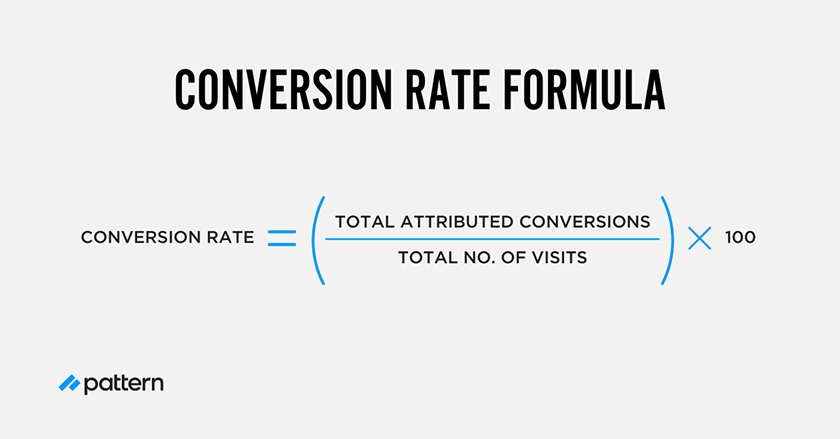Conversion Rate Optimisation, or CRO, is the process of optimising your website to increase the number of sessions that have a conversion. A conversion occurs when a user responds to a particular call to action or event. This could be anything from purchasing a product, to creating an account, submitting a form, signing-up for emails and more.
At its most basic level, CRO is finding out why visitors aren’t converting and solving the problem. By identifying the issue, breaking down barriers and simplifying the user journey, you will effectively be enhancing your website to improve your conversion rate.
How to Calculate your Conversion Rate
You can calculate your conversion rate by dividing the number of conversions (whether that be transactions, button clicks, sign-ups or any tracked event) by the total number of sessions on your website and multiplying by 100.
For example, if in one day you had 1,200 visits to your website and 15 transactions, your conversion rate would be 1.25% ((15/1,200) * 100).

What is a Good Conversion Rate?
The truth is conversion rates vary from industry to industry. What may be considered a strong conversion rate for a business that sells office furniture may be below average for a fast-fashion brand. A typical conversion rate will sit between 1.5% and 4%. However, this number is influenced by a number of factors from how well your channels are performing, how new or well-known your brand is, whether or not your products are a more considered purchase or the current situation in a given state or country.
The Pattern Ecommerce Benchmark Report that was released earlier this year reported an average conversion rate of 2.18% for FY21. This conversion rate is based on data amalgamated from a number of ecommerce sites from varying industries across Australia. This result was +18% year on year, driven by the impacts of COVID-19 and lockdowns with customers shopping from home.
Part of a good CRO program includes benchmarking your own:
- Website traffic (sessions or visits)
- Average transaction value
- Current conversion rate
Other key metrics such as time-on-page may also need to be identified based on your CRO goals. Once you have benchmarked key metrics, you will now know which of these levers can be pulled to improve performance and aid in achieving revenue targets.
Can I Perform Conversion Rate Optimisation Myself?
The short answer is yes, but how effective it will be is yet to be determined. The process of CRO involves identifying how users navigate your site, what actions they take and what is stopping them from converting. This process is time consuming and would benefit from a dedicated consulting resource to analyse, test, review and report on their findings.
Recruit some support from another department or a staff member unfamiliar with your website that can look at the user journey with a fresh set of eyes. Challenge them to find a certain product and make a purchase while screen recording their behaviour. Being familiar with the website experience can often camouflage issues that customers experience regularly.
Some conversion rate optimisation best practices you can initially consider are:
- Are your call to actions easy to find and use?
- Can your users quickly and easily find what they’re looking for on your website? If they use the search function, are they displayed the correct results in a well curated order?
- Do your category listing pages allow the customer to filter and sort by price, popularity, features & benefits, and colour? Can your users filter out products based on availability?
- Do your product display pages clearly describe the product with adequate care and size/fit instructions? Are you displaying all your payment and shipping methods?
- Do you have customer reviews and testimonials visible for users to read?
- Do you clearly display your privacy policy and communicate your users security is your top priority?
The above recommendations are by no means a comprehensive list and may or may not be relevant to your site but can quickly help you hypothesize what conversion blockers may exist on your website and help you to understand if you are capable of performing CRO yourself.
How Do I Start CRO?
In its most basic form, a CRO program can be broken down into 3 steps.
- Gather
- Test
- Repeat
Once you have established a baseline conversion rate and set achievable growth targets, it’s time to start gathering your data.
1. Gather Data
Start by gathering quantitative and qualitative data to understand the ‘what’ and ‘why’ to your CRO problem. Free tools such as Google Analytics allow you view the customers journey in a funnel and identify at what stage of the journey your users are dropping off. Paid software such as HotJar, WVO and Crazy Egg are cost effective and easy to implement, allowing you to view heatmaps of what your users are clicking on and viewing, watch recordings of your customers browsing and how they use your site, and also allow you to request feedback through pop-ups.
Use this data to develop a clear sense of what is happening on your site and what changes can be made to improve the Conversion Rate.
- At what stage of the browsing journey do your users drop off?
- What are customers saying about your website and brand?
- Are there any website interactions that can be easily enhanced?
2. Test
The most effective way to test changes on your website is through split testing or A/B/C testing. Split testing is comparing two versions of the same page against a control group to see which produces the strongest result. After a period of time you can take these learnings and implement them for all customers. Split testing requires a high volume of traffic to ensure you generate statistically significant results. Tools like Optimizely or Convert can be used to test different variations of your pages.
Some split tests that are often run on product pages include:
- Changing the position, size and colour of the add to cart button
- Adjusting the position of the size guide button
- Adding pop-ups that offer to take the customer to the checkout after adding to cart
- Comparing on-model vs. ghosted imagery.
3. Repeat
A CRO program should be considered as an always-on activity. It’s an ongoing process to help you learn more about your users and improve your conversion rate. Set yourself a realistic goal and continue testing until you reach it, and then start again.
Try not to test pages that are dependent on the same results, for example testing an alternate location or colour of your ‘add to cart’ button at the same time, as you will be unsure which change is driving the result. Test one element at a time to help narrow down which aspect is improving or reducing the conversion rate.
There is only so much you can do to identify barriers and solutions in the customer journey without the aid of experts or technology. If you would like some help identifying opportunities to improve conversion rate or to determine whether a Conversion Rate Optimisation program is suitable for you, get in touch with our industry-leading consultants at Pattern now.



